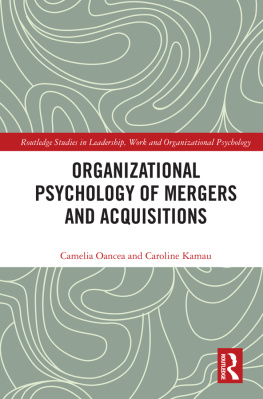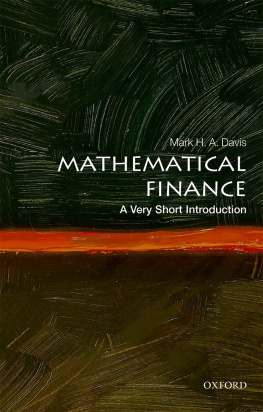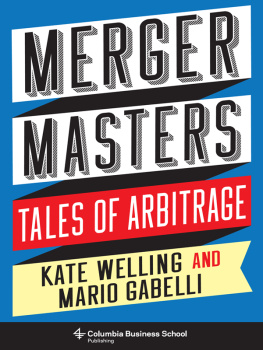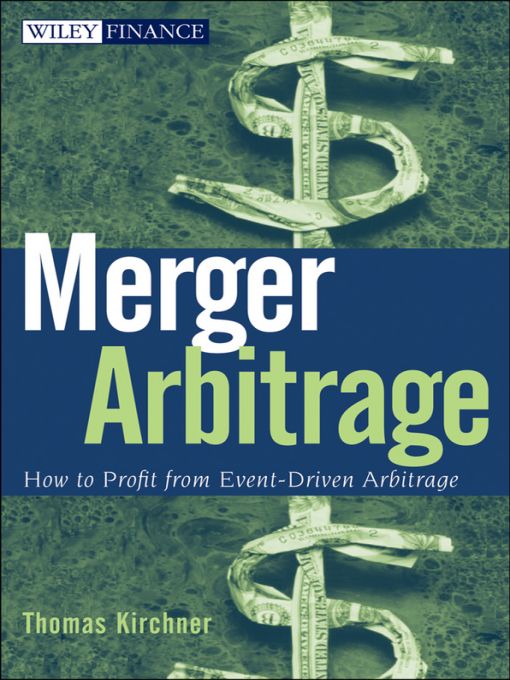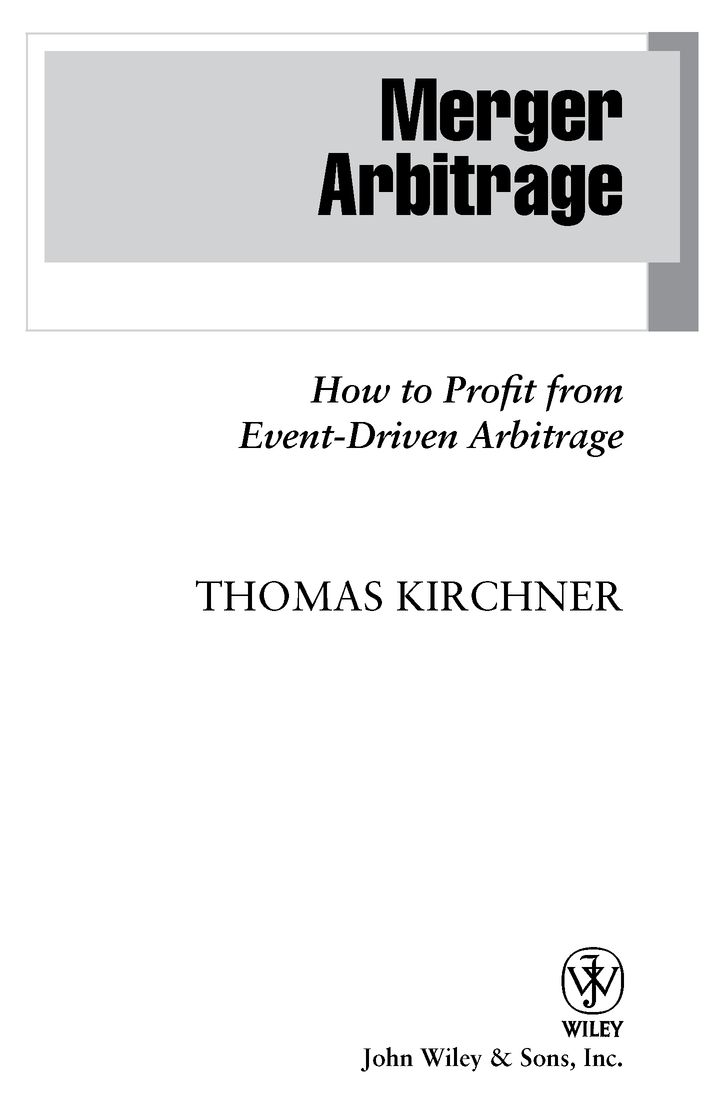Table of Contents
Founded in 1807, John Wiley & Sons is the oldest independent publishing company in the United States. With offices in North America, Europe, Australia, and Asia, Wiley is globally committed to developing and marketing print and electronic products and services for our customers professional and personal knowledge and understanding.
The Wiley Finance series contains books written specifically for finance and investment professionals as well as sophisticated individual investors and their financial advisers. Book topics range from portfolio management to e-commerce, risk management, financial engineering, valuation, and financial instrument analysis, as well as much more.
For a list of available titles, visit our web site at www.WileyFinance.com.
Preface
Merger arbitrage, also known as risk arbitrage, has grown exponentially over the last two decades from small operations within Wall Street firms to stand-alone arbitrage funds directly accessible to the public. Yet surprisingly little has been written on the topic. A number of academics have written studies about various aspects of the strategy. For the general public, I can count only five books on the topic. This small number pales in comparison to the information overload that other areas of finance experience. Since Guy Wyser-Prattes two monographs in the 1970s, only three other books about merger arbitrage have been published. One of them is Ivan Boeskys Merger Mania. Maybe potential writers fear that authoring a merger arbitrage book stands under a bad omen because Boesky was arrested a few weeks after the publication of his book. As the author of a merger arbitrage book, I certainly hope that writing a book and getting arrested are linked only by correlation and not by causality.
In this book I try to go beyond a mere description of the arbitrage process to incorporate some thoughts on the benefits of adding merger arbitrage to an investment portfolio and the vehicles investors can utilize to access the strategy. The expansion of the books horizon will make it more relevant to a broader investment audience. Nevertheless, the focus of the book remains on mergers and merger arbitrage, not asset allocation or portfolio management.
The book is organized into three parts: the first four chapters introduce the basics of the arbitrage process, Chapters 5 through 11 discuss what can go wrong, and Chapters 12 and 13 deal with some practical questions of investing in merger arbitrage.
Chapter 1 explains the basic types of mergers and how to set up the arbitrage. Chapter 2 expands the basic arbitrage by incorporating risk. Probabilities of failure and potential losses are incorporated into the return calculation to find an expected return of the arbitrage. Chapter 3 discusses different sources of risk and return in more detail, in particular the timing of mergers, leverage, and short sales.
The difference between mergers and tender offers is not well understood by many investment professionals. The terms are often used interchangeably. Chapter 4 goes into details and should be of interest to all investors, not just those seeking to read up on merger arbitrage.
Financing is often one of the most critical parts of an acquisition, and so Chapter 5 looks at different financing options.
Mergers are subject to a plethora of legal requirements, and I discuss them under different angles. Readers should keep in mind that this is a financial book, not a legal textbook. Many aspects are touched on only in a cursory manner. Boards of directors have to follow a number of procedures to ensure that a merger is fair to shareholders. This is discussed in Chapter 6.
Unfortunately, the law that is supposed to protect shareholders often is disregarded when managers buy the companies that they are managing as agents of their shareholders. Chapter 7 looks at management incentives for getting mergers done and how managers interests are often diametrically opposed to those of shareholders.
Similar conflicts of interest among managers, acquirers, and shareholders can be found in buyouts by private equity funds, discussed in Chapter 8. Now that the buyout wave of the monetarily lax Greenspan years has come to a halt, this is likely to be less of a concern for investors.
Minority squeeze-outs present risks of their own to merger arbitrageurs and therefore are discussed in a chapter of their own, Chapter 9.
The government gets involved in the merger process on several levels, both federal and state. Despite the obvious importance of government regulations, I have decided to relegate their discussion farther to the back of the book because I believe that the motivations of the market participantsmanagement, financiers, board membersare more relevant by far to the success of a merger than government regulations, discussed in Chapter 10. As they say: Where there is a will, there is a way.
Next, I step into a minefield by encouraging investors to seek to exercise their rights and get full value for their shares when a company is taken over. Chapter 11 describes methods that shareholders can use to that end. Too often have I seen investors resign when their company gets taken over for a lowball price. Most investors view themselves as stock pickers and throw in the towel too early. I hope that this chapter convinces investors, perhaps even some institutional investors, to fight for full value.
Chapter 12 explains the historical performance of merger arbitrage as an investment strategy and how it can be added to a diversified portfolio. This chapter in particular is relevant for investors who are looking to add merger arbitrage to their portfolio. Some background in modern portfolio theory is helpful for the understanding of this chapter, but readers without such knowledge should also be able to follow the thoughts and conclusions.
Finally, Chapter 13 gives some practical tips on investing in merger arbitrage. In particular, readers should recognize that cash holdings of event-driven investment strategies are dependent on events and not a deliberate asset allocation decision. As a result, merger arbitrageurs can have highly variable cash positions that are not an indication of their view of the market.
Chapter 13 contains some mathematical material. Stephen Hawking remarked in the introduction to his well-known A Brief History of Time that his publisher advised him each formula would reduce the potential readership by half. I trust that readers of financial books can handle a few formulas.
At the time of writing, the markets were in the midst of the worst financial crisis in a generation, the type of event that statisticians claim occurs only once in the lifetime of the universe. Financial markets could change dramatically once the crisis is over. It is difficult to forecast how much of the change will be mandated by the government or the financial industrys self-regulatory bodies and how much will be the result of Schumpeterian creative destruction. Writing any finance book in these times carries a severe risk of obsolescence of the text by the time it is printed. Even though I expect that the focus of the financial industrys changes will be in areas other than mergers, in particular in fixed income, without a doubt, collateral damage will affect arbitrageurs.
THOMAS KIRCHNER
Acknowledgments
I






